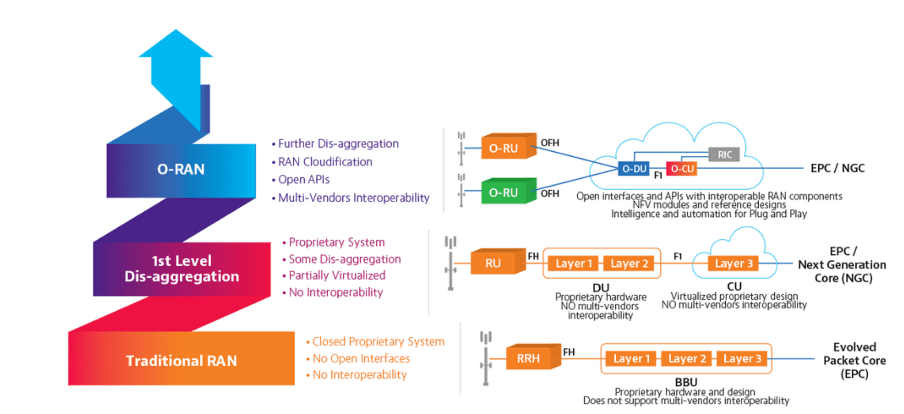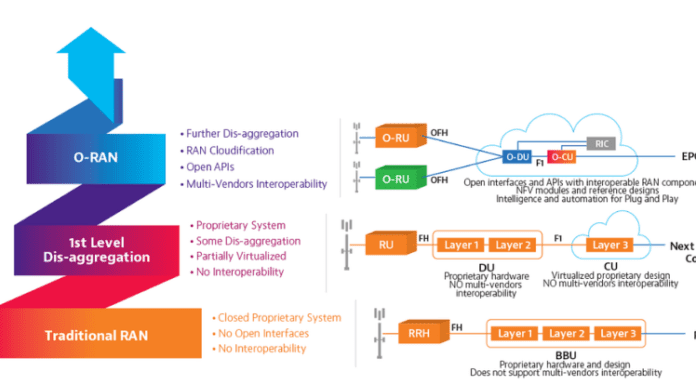As the evolution to 5G technology advances worldwide, network operators are increasingly interested in exploring open radio access network (Open RAN) technology. Open RAN is promoted as offering a host of business benefits for both incumbent and new mobile operators, including greater agility and supply chain diversification.
Most importantly in this highly competitive market, lower total cost of ownership (TCO) and faster time to market with new services are among the key benefits touted for migrating to an Open RAN architecture, according to a survey conducted by industry analyst firm Analysys Mason.
The key aspects of Open RAN architecture are the virtualization and increased cloudification of the radio network. The network virtualization done over the past several years focused on the core rather than the RAN. The cost of the radio network is a major part of the overall cost of the end-to-end wireless network. Virtualization and cloudification of the RAN make it possible to leverage commercial off-the-shelf (COTS) servers for running the baseband software.
Although the terms Open RAN and vRAN sometimes are used interchangeably, they encompass different concepts. Open RAN — especially as promoted by the Open RAN Alliance — goes beyond vRAN by providing a framework for open interfaces and interoperability in a multi-vendor environment. Organizations such as the Open RAN Alliance and Telecom Infra Project (TIP) are working with the broader ecosystem to standardize and define Open RAN architecture, enabling true disaggregation and greater virtualization — capabilities that allow operators to reduce deployment costs by up to 50%.
Figure 1:

That disaggregation highlights another potential benefit of Open RAN: freedom from vendor lock-in. But the ability to mix best-of-breed hardware and software comes with a very big caveat: Operators now bear the responsibility of system integration in a highly complex, multi-vendor environment. If that weren’t enough, they are doing this integration with a brand-new technology — 5G — which has its own learning curve. And the risks associated with this need to be carefully managed.
Consumers and business customers don’t know that Open RAN exists. But they do know that 5G is supposed to provide a user experience that’s superior to 4G, such as in terms of faster speeds and lower latency, in addition to driving business improvements across a wide variety of industries — from private networks for industrial manufacturing and enterprises, to assisted driving, smart parking, smart ports, connected grid, connected health, etc. As a result, operators also need to do two things: ensure that their 5G network meets those expectations and ensure that the roll out of their Open RAN 5G network doesn’t undermine the performance of their 4G RAN.
How to ensure a successful Open RAN deployment
Testing has always been critical for ensuring network performance and subscriber quality of experience. But network test and validation are particularly important when Open RAN architecture means mobile networks are more complex than ever. Agility, interoperability and precision are key principles for demanding new use cases, such as autonomous vehicles that require latencies lower than 5 milliseconds. Compare that with the “handshake” process in a 4G mobile network that can take 50 milliseconds just to establish connectivity.
These capabilities also help operators pursue enterprise applications with strict service-level agreements (SLAs). By helping to ensure that the Open RAN 5G network meets those marketplace requirements, testing directly improves an operator’s competitive position and revenue opportunities.
Introducing Open RAN into the network has several major challenges and considerations:
- The performance has to be at least as good as the legacy RAN.
- The multi-vendor architecture has to work seamlessly.
- Operators need access to granular network data in order to enable service assurance.
- Brownfield operators have to ensure seamless swap and optimization of the network.
- A snapshot in time of the performance may not be enough and continuous monitoring and verification would be needed to adapt the dynamic changes in the Open RAN network.
To overcome these challenges, network equipment providers and operators are using specialized labs to test Open RAN hardware and software in a wide variety of scenarios prior to commercial launch. They are also emphasizing the need to bring real deployment field data back to the lab to enrich the verification process continuously and dynamically. There are already 5G networking and interoperability test labs that focus on multi-vendor integration, verification, interoperability and performance. They will play a key role in ensuring that Open RAN 5G lives up to its potential.

